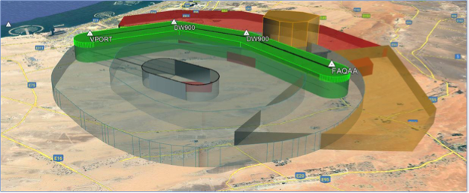Advanced air mobility (AAM) infrastructure developer VPorts partnered with the United Arab Emirates General Civil Aviation Authority (GCAA) and the Mohammed bin Rashid Aerospace Hub (MBRAH) at Dubai South in December 2022 to establish an AAM integrator center in the UAE. The project includes dedicated flight testing airspace, assigned blocked airspace and new technologies that are intended to grow the international AAM industry and accelerate the certification of electric vertical take-off and landing (eVTOL) aircraft. Development of the center will begin in 2023 and it is expected to begin operations and conduct its first flight test in 2024.
Dr Fethi Chebil, CEO and founder of VPorts, said, “We use the term integrator because today there are three pillars to AAM: the eVTOL manufacturers, infrastructure and traffic management. Currently, eVTOL manufacturers don’t interact with the second two pillars very much because their investors are pushing them to focus on the technology over everything else. There are almost 360 companies in the first pillar and 600 eVTOL prototypes in the world right now. They are all looking to gain thousands of hours of flight to develop their machines and demonstrate that they are safe. As an integrator, our core business is uniting the infrastructure and air traffic management required for eVTOL manufacturers. With this center, we are building the ecosystem around AAM – bringing together all the players to enable multiple, simultaneous tests and speed up the adoption of eVTOL.”

Relationships with authority
According to VPorts, the center’s primary selling point is this inherently intimate relationship with civil aviation authorities. Prior to securing this partnership, the company spent a year working with the GCAA, explaining the need for dedicated airspace and how it would be operated to enable easy flight testing.
“In Europe and the US, it is very time-consuming, expensive and complicated to get eVTOL flight approval,” explains Chebil. “You have to detail your exact timings, flight route, traffic avoidance plan, and demonstrate that the flight is safe. Even if the organizations give their final authorization, it is given by flight, not by mission. When we ask certification authorities, ‘Why are you late in terms of regulation?’, the organizations say, ‘We don’t have the aircraft performance data yet, we need them to fly to understand them better.’ However, when you ask aircraft manufacturers, ‘Why aren’t you certified yet?’ they say, ‘The aviation authority won’t allow us to fly.’ It’s a circle that the industry does not know how to get out of.”
According to Chebil, the solution to this bureaucratic hurdle is simple: fly with VPorts. As a private operator that is accountable to the GCAA and air navigation service providers (ANSPs), VPorts is responsible for making sure the aircraft procedures are both safe and efficient. “This means that if an advanced air mobility manufacturer wants to fly, it doesn’t need to talk to any other party,” he adds. “You come to the center, you fly, then you go. There’s no need to do anything else.” The company will invite regulation authorities from around the world to the center to witness test flights and build regulatory frameworks for their respective jurisdictions.
At the center, VPorts will offer two types of airspace for its two air traffic management testing business cases – sensors and air navigation. It will test air navigation and irrigation system sensors, communication protocols and weather protocols along a flight corridor. This corridor will stretch from VPorts in Dubai South, avoid the existing Al Maktoum Airport and arrive at the free testing area. Here, users can test any flight configuration and fly to a maximum height of 2,134m.
Good growth
Beyond testing, VPorts’ growth strategy incorporates the transportation of goods throughout the region. Its commercial cargo operations are expected to kick off between 2025 and 2028, once the commercial flight testing use case has run its course. This interest in cargo fed into the company’s strategic site selection.
Within Dubai South specifically, VPorts chose a location close to Al Maktoum Airport’s helicopter operation. “We believe that by 2030, there will be a lot less helicopter traffic than today. By 2040, we expect that eVTOL will become more user-available than helicopters and so we plan to take over all this land,” Chebil comments. Overall, almost half of the 37,000m2 of VPorts-occupied land (18,000m2) will be for vertiports and hangars, and almost 2,000m2 is available for the Vertiport Operation Control Center (VOCC). The remaining 17,000m2 is intended to be used for the offices and other developments.
The VOCC is an integral part of the company’s integration ethos. It will have the capacity to manage air traffic integration and set up communication protocols between eVTOLs, vertiports and ANSPs. It will also leverage AI to assess data related to resource management. The aim is to ensure efficient, timely decision making processes for all eVTOLs landing, taking off from or flying to any vertiport in a potentially global network of sites. Incorporating state-of-the-art technology, the VOCC is expected to enable VPorts to centralize operations for optimal efficiency. It will also have the capacity to manage non-flight-related operations, including cargo, personnel and airside management, commercial activities, security screening, cybersecurity, ground handling and aircraft charging.

Design considerations
While VPorts is well prepared for the testing and cargo use cases, the company also sees the potential for the transportation of passengers. “Passengers are our objective, but we are pragmatic,” Chebil explains. “We don’t expect passengers to fly at the beginning. For the movement of people, social acceptability will always play a part in this consideration. So, to generate revenues as soon as possible, we’re creating this business case around testing, then cargo and health-related products like transplant organs, and then passengers.”
To fit the center around this efficiency ethos, the company will develop an app to support clients’ self-sufficient wayfinding, enabling them to select their research area and destination, ready for their time at the aviation center. Once at the vertiport, VPorts will connect to users’ phones directly and begin guiding them to their flights – without a map. Instead, the app will track a user’s location and dynamically respond with ‘left’ and ‘right’ as needed.
The center is expected to foster a risk-based security approach, where passengers are only stopped if something is wrong – rather than being stopped for body, bag and shoe searches as a matter of course. “Because the flight is very short by definition, the whole airport process has to be very quick, so we will do everything to align with that,” Chebil adds.
Future plans
Looking to the future, VPorts aims to build and operate 1,500 vertiports around the world by 2045, which will be integrated into local and global air mobility ecosystems. To do this, the company will spend 2023 building an extended partner network with expertise in eVTOL manufacturing and flight simulation and training, plus regulators, ANSPs, technology service providers, operators, electric charging manufacturers and urban planners.
“We are also planning on hiring a real-estate company to develop the other lands into offices and suchlike. Overall, the main challenges of developing this infrastructure are the funding, the certification and the regulatory framework that are required for the machine to fly. Therefore, our investors will shape the timeline and the way we move forward,” Chebil concludes.
This article was originally published in the April 2023 issue of Passenger Terminal World magazine

